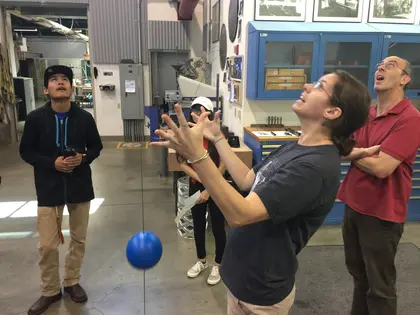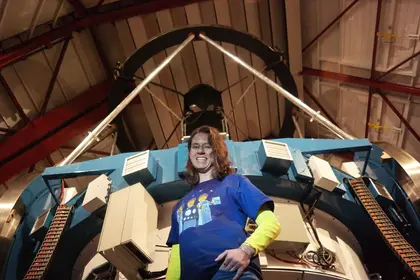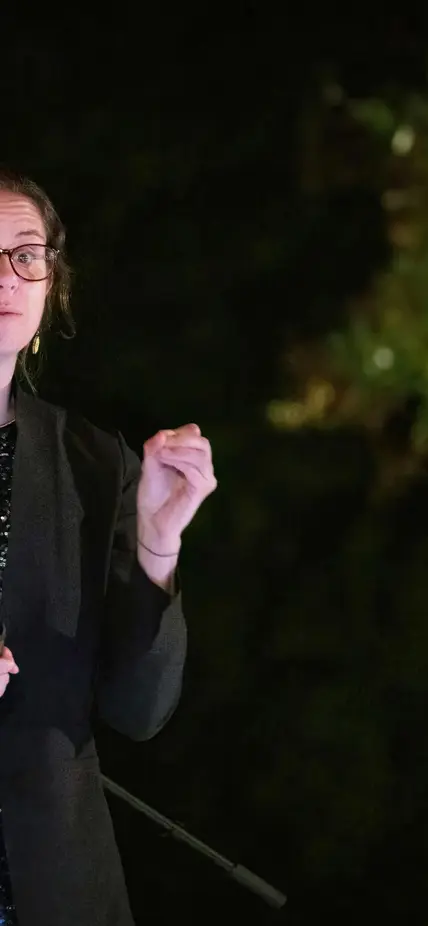
Washington, D.C.—Carnegie Science announces astronomer Johanna Teske as the first jointly appointed Staff Scientist between its research divisions for astronomy and astrophysics and Earth and planetary science.
Teske joined Carnegie Science’s Earth and Planets Laboratory as a Staff Scientist in 2020, following two postdoctoral fellowships at the organization. In her new position, Teske will have opportunities to grow her research and partner more closely with staff in both divisions, while helping to build Carnegie Science’s eminence in exoplanetary research.
As a joint appointee, Teske will help drive the science and enhance capabilities for exploration in one of the most compelling research topics in science—drawing on both the Earth and Planets Laboratory’s long-standing leadership in the field and the Carnegie Science’s Observatories 100-plus-years of pioneering discoveries in astronomy and developing novel astronomical instrumentation.
“I am delighted that Johanna has agreed to take on this joint position with the Earth and Planets Laboratory and the Observatories. In this new role, she will have the opportunity to advance the science of exoplanets by collaborating and leveraging the combined expertise of both divisions. We believe that such joint positions will be one way for Carnegie Science to continue to innovate and lead in our science,” said Carnegie Science President Eric Isaacs. “Johanna’s new appointment is a pilot program that will help us to better understand how best to leverage future joint appointments in other areas of research.”
Teske’s work aims to better understand the processes of planetary formation and explain why there is so much planetary system diversity in our galactic neighborhood. She uses observational data from the telescopes at Carnegie Science’s Las Campanas Observatory, as well as from space-based telescopes like JWST to constrain the possible compositions of the interiors and atmospheres of extrasolar planets, as well as the chemical environments that led to their formation. Her work could also help identify candidates from among the over 5,000 known exoplanets that could have the right conditions to host life as we understand it.
“The evolution of planetary architectures and exoplanetary systems, the factors that contribute to planetary habitability, and the search for signs of life on other worlds are interconnected areas of investigation at the cutting edge of science,” said Earth and Planets Laboratory Director Michael Walter. “Maintaining Carnegie Science’s leadership position across these avenues of research was a top priority for us and Johanna’s new appointment is a major step toward advancing this goal.”

Teske has worked closely with planetary science experts at the Earth and Planets Laboratory and with instrumentation experts at the Observatories, as well as with researchers from academic institutions around the world to make many exciting contributions to the exoplanet field. She has helped advance a new understanding of exoplanets using JWST, both as a member of the mission’s Transiting Exoplanet Community Early Release Science Team and as a principal investigator on three projects—one from each cycle of telescope time allocation.
She has played a role in several notable discoveries, including the first Earth-sized planet found by NASA’s Transiting Exoplanets Satellite Survey (TESS), a cold super-Earth orbiting the second-closest star to our own Sun, a super-Tatooine system of two stars hosting three planets, and more. Additionally, she is already actively engaged in multiple instrumentation efforts, including the Carnegie Science Planet Finder Spectrograph (PFS), the Magellan Infrared Multi-object Spectrograph (MIRMOS), and the Warm INfrared Echelle spectrograph to Realize Extreme Dispersion (WINERED).
"I'm very excited to continue what I started during my Origins Fellowship, building on the long-standing cross-divisional partnership in the PFS team and including more people and different research projects,” Teske said. “I have found in-person interactions to be really important for getting to know people, understanding what drives them scientifically, and where there could be overlap in research. I think the best collaborations start with a foundation of trust and thrive when given enough time to explore and be creative—that’s what I hope to do with this joint position."

Teske is also an enthusiastic member of the Carnegie Science community and participant in campus life activities both in Washington, D.C., and Pasadena, particularly as it relates to undergraduate internship opportunities on both coasts and to diversity, equity, and inclusion efforts. Her excellence has been recognized with multiple internal grants and awards over the years.
Prior to joining Carnegie Science, Teske earned a Ph.D. in astronomy from the University of Arizona and a bachelor’s degree in physics from American University.
